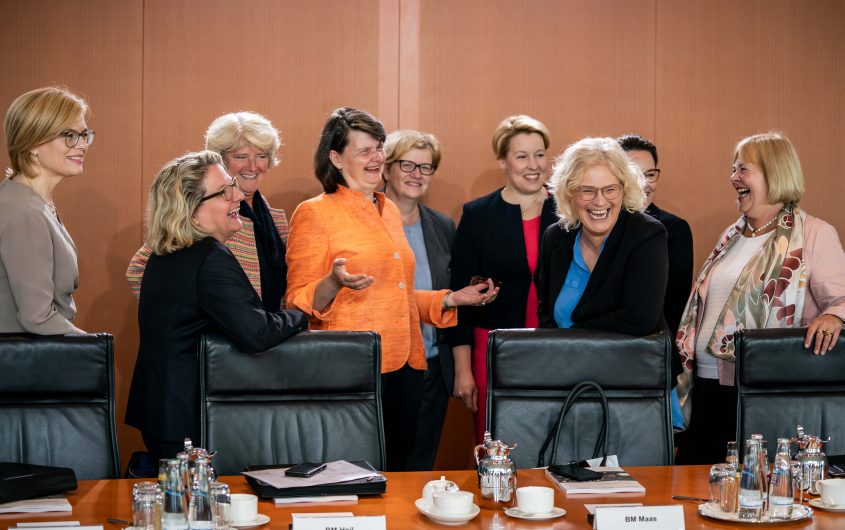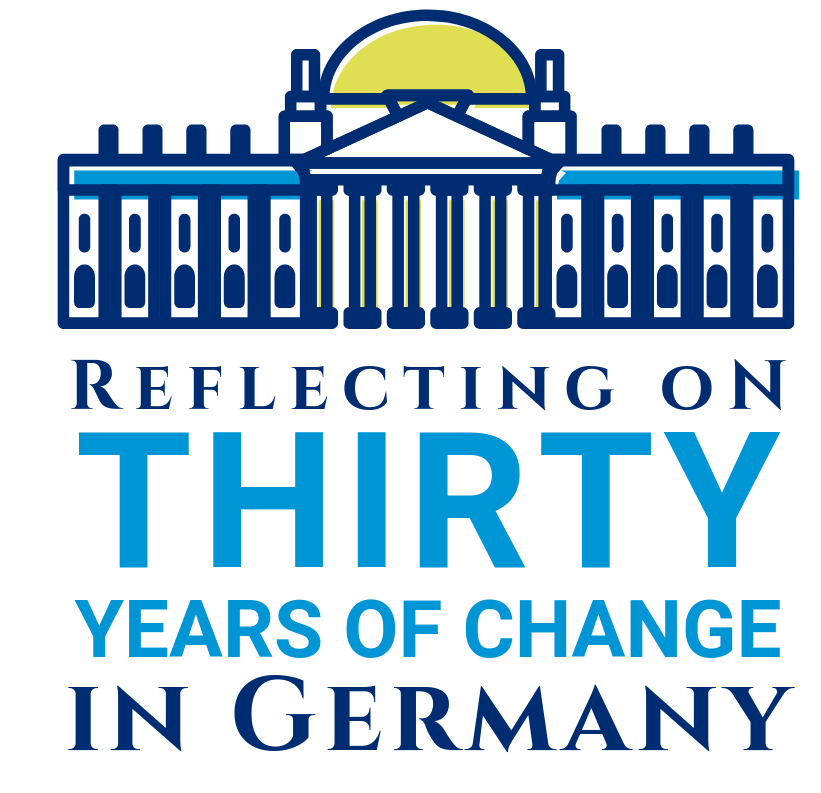
Michael Kappeler/picture alliance via Getty Images
Deutschland einig Mutti-Land?

Joyce Mushaben
University of Missouri - St. Louis
Joyce Marie Mushaben is a Curators’ Professor of Comparative Politics and former Director of the Institute for Women's & Gender Studies (2002-2005). Fluent in German, her teaching centers on comparative public policy, the European Union, women's leadership, citizenship, immigration, mega-cities and sustainability issues. Her research covers new social movements, youth protest, German unification and identities, gender, ethnicity and welfare issues, EU migration and integration studies.
Her books/monographs include Identity without a Hinterland? Continuity and Change in National Consciousness in the German Democratic Republic, 1949-1989 (1993); From Post-War to Post-Wall Generations: Changing Attitudes towards the National Question and NATO in the Federal Republic of Germany (1998); The Changing Faces of Citizenship: Integration and Mobilization among Ethnic Minorities in Germany (2008); and, Gendering the European Union: New Responses to Old Democratic Deficits (co-edited with Gabriele Abels, 2012). Her latest book focuses on Becoming Madam Chancellor: Angela Merkel and the Berlin Republic (2016). Her articles have appeared in World Politics, Polity, West European Politics, German Politics, German Politics & Society, the Journal of Peace Research, Democratization, Politics & Religion, Citizenship Studies, Journal of Ethnic & Migration Studies, German Law Review and Femina Politica. A past president of the German Studies Association (USA), she has also served on the Executive Boards of the International Association for the Study of German Politics and the German Studies Association, as well as on selection committees for Fulbright, the German Academic Exchange Service and the American Council of Learned Societies. She is a current Editorial Board member for German Politics & Society, German Politics, and Femina Politica.
Having received a 1999 Trailblazer Award and the Chancellor's Award for Excellence in Research Creativity in 2007, Mushaben is a three-time Alexander von Humboldt Fellow, a former Ford Foundation Fellow, German Marshall Fund grantee and DAAD recipient. She has held guest-scholar posts at the Academy for Social Sciences (GDR), the Center for Youth Research (GDR), the Chinese Academy of Social Sciences and the Center for Transdisciplinary Gender Research (Berlin). She was named the first Research Associate in the BMW Center for German & European Studies at Georgetown University, has enjoyed Visiting Professorships at the Ohio State University, Berlin’s Humboldt University, the Missouri-London Program and at the Universities of Erfurt, Stuttgart and Tübingen (Germany) , inter alia. Affiliated with the American Institute for Contemporary German Politics (Washington D.C.) and a designated Fulbright Specialist, she is commonly known as "Dr. J."
Characterized as “the triumph of the Vaterland,” unification was a male-normed, male-dominated process, despite the significantly different gender regimes found in the two German states through 1989. In July 1990, Helmut Kohl promised to turn Eastern states into “blossoming landscapes in which it paid to live and to work again,” insisting that no one “would be worse off than before.” Excluding women from the negotiating table, he nonetheless relegated gender issues to the back burner.
Read more on the Fall of the Berlin Wall from AGI
 GDR women were soon hit by mass unemployment and the elimination of support services, rendering them the disproportionate “losers” of unification. Although Western females failed to display solidarity toward their Eastern sisters, they have become the primary beneficiaries of a great leap forward in gender equality since 2005, advances they owe to a female eastern CDU chancellor who refuses to label herself a feminist. Angela Merkel turned unification into a triumph of the Motherland by re-instating many gender rights that GDR women had taken for granted prior to 1990.
GDR women were soon hit by mass unemployment and the elimination of support services, rendering them the disproportionate “losers” of unification. Although Western females failed to display solidarity toward their Eastern sisters, they have become the primary beneficiaries of a great leap forward in gender equality since 2005, advances they owe to a female eastern CDU chancellor who refuses to label herself a feminist. Angela Merkel turned unification into a triumph of the Motherland by re-instating many gender rights that GDR women had taken for granted prior to 1990.
Although Western females failed to display solidarity toward their Eastern sisters, they have become the primary beneficiaries of a great leap forward in gender equality since 2005, advances they owe to a female eastern CDU chancellor who refuses to label herself a feminist.
Eastern women were nervous about unification from the start: only 41 percent “strongly” favored unity (58 percent among men), while 20 percent were outright opposed (8 percent among men).[1] Women’s rights were enshrined in the Unity Treaty (Art. 31) under “family rights,” reflecting conservative notions of women’s “proper role.” Instead of seeing their lives improved, women were blown away by a gale of “creative destruction,” as industrial production plunged by 60 percent, and GDP fell by 40 percent. The number of regularly employed declined from 9.7 million in 1989 to 5.3 million in 1992. Having comprised 48 percent of the GDR workforce, women accounted for 59 percent of the unemployed by 1993.
They also lost a host of work-family reconciliation benefits. Though their motives had been more pro-natalist than emancipatory, SED leaders introduced a “birth grant” for women bearing multiple children in the 1950; in 1972, they extended a payment of 1,000 Marks to all mothers, provided they underwent free pre- and post-natal check-ups. Couples who married young received better access to apartments and household loans of 5,000 Marks, which they could subsequently “abkindern”: a first-born cancelled 1,000 Marks, a second another 1,500 Marks, and a third child the remaining 2,500 Marks debt. Legalized in 1972, free contraception and abortion would disappear by 1993. GDR abortion rates did not exceed those in the West, where it has remained illegal since 1871.
Working mothers with three or more offspring were granted extra vacation days, reduced work-hours, and one paid day per month for house-cleaning. Single mothers (33 percent of all births by 1985) received priority access to subsidized child-care and were guaranteed paid leave to care for sick children. Introduced in 1976, the so-called “Baby Year” for multiple births was extended to all mothers in 1986. Prior to 1989, 91 percent of GDR women aged 15-65 were engaged in vocational training or paid labor, 90 percent of whom also became mothers. This contrasts with a 48-54 percent employment rate among FRG females; only 10 percent of mothers held full-time jobs, 29 percent worked part time, 59 percent stayed home. The FRG school day ended at 11:30am, and mothers were supposed to be home to serve their children a warm lunch.
By 1995, female unemployment rose to 63.7 percent.[2] Their skilled labor certifications in “non-traditional” branches were often not recognized in the West. Despite Unity Treaty guarantees, women were accorded only one-third of the federally-funded ABM (job-creation) places; they were significantly less likely to be hired by Western employers in banking, insurance, and engineering sectors, where they had been a major presence. Most over age 55 were sent into early retirement.
The post-unity “birth benefit” was cut from 1,000 Marks to DM 150, though rents rose 200-500 percent, as 2+ million Westerners sued to “reclaim” properties expropriated by the GDR state after 1949. The marriage loan was abolished in favor of breadwinner-centered tax-splitting, to discourage married women from seeking paid work.
State childcare centers were not subject to privatization, but Kohl made new communal governments liable for DM 350 billion in old GDR debt, forcing municipalities to shut down care facilities—exacerbating female unemployment at two levels. Charged with liquidating 40,000 enterprises, the Treuhand (the holding company tasked with privatizing East German assets) created 4,200 positions for mostly Western staff; 72 percent of the 4.1 million who had labored in those plants lost their jobs. By the time it shut down in 1994, Westerners had acquired 80 percent of the privatized enterprises, some for as little as one Deutsche Mark; Eastern citizens secured a mere 6 percent, due to their lack of capital and collateral assets.[3]
Not surprisingly, Eastern birth rates plunged by 40 percent after 1990, while sterilizations rose by 500 percent. Western analysts referred to this as a birth-strike, predicting that total population would drop from 82.5 million to 69 million by 2050.[4] I offer a different explanation: While GDR woman gave birth, on average, between ages 20 and 25, FRG females started reproducing between 27 and 30. Fertility rates also diverged: 90 percent of GDR women were mothers, compared to 60 percent among Baby Boomers in the old FRG. GDR births peaked between 1959 to 1965, rising again in the mid-1980s.[5] Thus, 1990/91 marked the end of an Eastern birth cycle, as indicated by the sterilization data: 90 percent involved women 36 or older, over 60 percent of whom had two or more children.
Women born prior to 1970 would have already established families; low teen pregnancy rates mean that cohorts born 1971 or later (under 19) had not. When the Wall fell, younger, better educated women were the first to pack their bags to “see the world” or seek jobs in the West. Of 16.4 million GDR citizens, 4.2 million have abandoned the East since 1989, 52 percent of whom were female; as late as 2015, 18-29 year-olds comprised 47 percent of the out-migration group. Demographically speaking, this represents a “fertility-potential loss” of 1.2 million women.[6] Over 2.3 million mostly middle-aged Western men moved eastward to occupy top political, administrative, and economic posts. In 2007, Mecklenburg-Vorpommern initiated a public campaign to find wives for its “abandoned” rural men, equivalent to Norwegian bachelor farmers in Lake Wobegon. Unification taught GDR women that, for them, more freedom equals fewer rights.
Unification taught GDR women that, for them, more freedom equals fewer rights.
Given her GDR socialization and her career in the man’s world of physics, one can understand Angela Merkel’s hesitation to view women’s paid employment and state-supported childcare as radically “feminist” demands. Nor she was looking to exchange one “ism” for another, after “35 years in the waiting room of democracy.” As Minister for Women (1990-1994), she was pressured from all sides regarding abortion, though Kohl had shifted that responsibility to the Justice and Health Ministries. Western and Eastern feminists differed on everything from motherhood, abortion, and employment to attitudes toward men, identity politics, and state funding. Both groups had been shaped by socialization processes that constantly pitted them against each other, to “stabilize and support” their respective ideologies.
Western feminists quickly asserted their superiority vis-à-vis Eastern stepsisters, labeling them “theoretically naive.” Internally divided over various types of feminism, Western women were too busy critiquing patriarchy, and each other, to pursue pragmatic, single-issue coalitions. Devastated by the Constitutional Court’s (re)criminalization of abortion in 1993 (“illegal but unpunishable”), and frustrated by cultural misunderstandings, both groups returned to their separate niches, feeling betrayed on both sides.
Merkel’s proclivity for learning-by-doing produced a change in her view of quotas, which she initially labeled “degrading.” Recognizing the barriers women faced in her own party, she voted for a CDU “quorum” in 1994. She rejected corporate boardroom quotas demanded by EU feminists and conservative labor minister Ursula von der Leyen in 2011, but when forced to clean up the Euro crisis mess created by male-dominated global finance, she reversed that position; she accepted mandatory 30 percent targets in 2014, after “voluntary” quotas failed to increase women’s presence on DAX-listed supervisory boards.
The addition of twelve new EU members in 2004-2005 mitigated the perception that Easterners were the odd ones out. Realizing that Sweden, Denmark, Finland, France, and the Netherlands provided the same services that GDR women had enjoyed vindicated the latter. The fact that roughly one-third of all Germans will be 65 by 2050, makes it easier to present women’s paid labor as quintessential to national economic sustainability.
Increasing women’s numerical strength is ultimately a function of “all things being equal,” which they usually aren’t. From 1998 to 2005, female cabinet members in a Red-Green government pushed for an (EU-mandated) anti-discrimination law, gay partnerships, expanded childcare, and even corporate quotas. These measures were deliberately blocked by Chancellor Gerhard Schröder, who socialized with CEOs, wore designer suits, and married for a fourth, then fifth, time before going to work for Russian-owned Gazprom.
Merkel’s first Grand Coalition adopted the General Equal Treatment law in 2006, adding a federal office to monitor discrimination. Her 2007 National Integration Plan included special initiatives for women and youth. She also accorded priority status to increasing female participation in STEM fields, declaring in 2013 that real equality will only be achieved “when both men and women change their roles and behaviors.” Though she voted against the “Marriage for All” act in 2017, she allowed CDU parliamentarians to vote their conscience, securing a clear majority for that bill, along with a liberal transsexual-rights law.
Total female employment has risen over 10 percent since 2005, up to 72 percent in 2016.
Total female employment has risen over 10 percent since 2005, up to 72 percent in 2016. Since 2015, parents can split or share up to 36 months of paid leave after childbirth or adoption, applicable until a child’s 8th birthday. In 2008, her government granted every child three or older the right to a nursery or day-care place, extended to every child over 12 months in 2013. For Easterners, EU mandates on family-work reconciliation, childcare, and promoting women in science and technology suggests a return to past “social achievements.” For Western women, feminist or not, these actually amount to new rights.
So what is the state of the gender union, thirty years later? Improved leave and care options do not “cause” women to reproduce, but they can affect the timing of such decisions. By 2017, unemployment had declined to 7.6 percent for Easterners, 5.3 percent for Westerners. Women again account for 49.3 percent of the Eastern workforce; although many in low-wage, part-time jobs would rather work full time, they have benefited from the 2015 minimum wage law, which raised their wages by 7 percent. The gender pay gap persists, but Western women (22%) lag farther behind; East wages (7% gap) have not reached parity with West earnings (85%). In 2019 Eastern pension benefits reached 96.5 percent.
Employment among mothers rose from 60 percent to 67 percent between 2006 and 2016, and even from 32 percent to 44 percent for those with children under two; 43 percent of Eastern mothers work full time, versus 20 percent of Western women logging more than 36 hours. Among single mothers, 80 percent in the East work at least 28 hours per week, versus 59 percent in the West. In 2017 Berlin health minister Dilek Kolat had to convene an emergency summit to address a mid-wife shortage thanks to the highest birthrates in forty-three years. There has also been a noteworthy increase in men taking advantage of new leave policies, 36 percent by 2015. In 2017, 57.8 percent of new parents in Jena took advantage of the “partnership bonus,” compared to 16.1 percent in Berlin and 12.4 percent in Hamburg. The state now spends about €265 million per year on family subsidies.
Angela Merkel freely admits that she has changed a great deal since 1990. Power will do that to a girl. The question is whether she has also helped to change the power structures. Her first three cabinets were over 40 percent female. In 2013 she appointed her family-turned-labor minister, Ursula von der Leyen, as the nation’s first female defense minister. In December von der Leyen will become the first woman President of the European Commission; for the first time since the Community’s founding in 1957, it will consist of equal numbers of women and men. Von der Leyen, a former medical doctor, is the mother of seven children.
Women now manage 50 percent of the cabinet portfolios and head half of all Federal Chancellor’s Office (FCO) departments. Of the 19 (of 450) aides who gave birth during Schröder’s last 35 months in office, few returned to work. There were 49 FCO births during Merkel’s first 32 months, most of whom resumed their posts; the pool of those eligible for high administrative office has expanded accordingly. The number of women having served as Minister-President rose from one prior to 2004, to six by 2017, two of whom head Eastern Länder. The CDU now has its second woman Chair, added to three female co-chairs leading the SPD, Linke, and the Green (three Eastern women).
Women’s share of Bundestag seats rose from 31.8 percent (2005), to 33.4 percent (2009), to 37 percent in 2013. It fell to 30.9 percent in 2017 due to the entry of right-wing populists. The parties railing the loudest against Merkel’s policies evince the smallest female delegations: the AfD, the FDP, and the CSU.[7] Eastern females outnumbered their Western counterparts at the state level through 2004. In 2019, their presence declined to 27.7 percent in Saxony, 23.4 percent in Thuringia, and 31.8 percent in Brandenburg, respectively—despite the latter’s new parity law mandating equal numbers of male/female candidates on the ballot. Male AfD supporters outnumber females almost two to one, concentrated between the ages of 34 and 59. Right-wing populist are scoring double-digits in Eastern states, paradoxically, while rejecting feminist policies in order to “end the gender madness.” Roughly 60 percent of parents with children under 3 believe that men and women should share family and household responsibilities; 78 percent (East) and 57 percent (West) favor “reconciliation” support systems.
Conclusion
The terms of unification dictated by male conservatives in the West to resource-poor male negotiators in the East had a devastating economic, social, and psychological impact on GDR women. In the “State of Workers and Peasants,” as the East German motto put it, jobsites constituted the core of social networks; co-workers celebrated birthdays, undertook cultural outings, and helped each other in securing scarce commodities. Ensuring women’s economic autonomy, factories often had their own vacation resorts and health clinics. Losing one’s job meant losing all of those things at once. Thirty years later most still embrace paid employment as a core component of their identities.
This does not mean that women want to return to the old regime. They clearly value democracy, freedom to travel, better health care, and cleaner environments. My core objection, then as now, rests with the deliberate exclusion of women and their needs from all negotiations, a pattern that continued across the first two decades of unity. Kohl and his government chose neo-liberal austerity policies over the constitutionally grounded social-market economy mechanisms that had produced a WEST German Economic Miracle within ten years of unconditional surrender. Thirty years later, the East still lags behind.
The biggest change of all is that attitudes regarding the state’s constitutional obligation to pursue gender equality have taken hold in the OLD Federal Republic.
The biggest change of all is that attitudes regarding the state’s constitutional obligation to pursue gender equality have taken hold in the OLD Federal Republic. Western feminists no longer reject government intervention in gender domains because they are no longer ruled by Father State, but rather by Mutti Merkel. Women utilizing childcare facilities are no longer disparaged as “raven mothers.” Hostility toward the patriarchal state is fading insofar as Merkel’s reforms have produced real changes not only in the rights of women, but also in the domestic responsibilities of men.
Karl Marx posited in the 1800s that societal development is driven by a process known as “the dialectic”: thesis collides with antithesis, resulting in a new synthesis. It is rather ironic that it took a childless Eastern physicist—and a pastor’s daughter to boot—to persuade Western Christian conservatives that women’s rights are an essential component of “the national interest.” In many respects, Merkel has become the personal embodiment of the dialectic, emerging as the mother of a new, more gender equitable German nation. She will be a very tough act to follow.
[1] Joyce Marie Mushaben, “Second-class Citizenship and its Discontents: Women in the New Germany,” Peter H. Merkle, ed., The Federal Republic at Forty-Five: Union without Unity (New York: New York University Press, 1995), p. 84.
[2] All data derived from Gunnar Winkler, ed., Frauenreport ’90 (Berlin: Die Wirtschaft, 1990), and Gunnar Winkelr, ed., Sozialreport 1995 (Berlin: Sozialwissesnschaftliches Froschungszentrum, 1995).
[3] Jörg Roesler, “Die Treuhandpolitik,” Hanes Bahrmann and Christoph Links, eds., Am Ziel vorbei: Die deutsche Einheit – Eine Zwischenbilanz (Berlin: Ch.Links, 2005), p. 96, p. 102.
[4] Wolfgang Weiβ, “Die Schrumpfung der Städte. Abwanderung aus dem Osten und die sozialen Folgen,” Am Ziel vorbei,, pp. 194-207.
[5] Frauenreport 90, pp. 23-24.
[6] Gunnar Winkler, ed., Sozialreport 2017, p. 268.
[7] Deutscher Bundestag website 2017.









